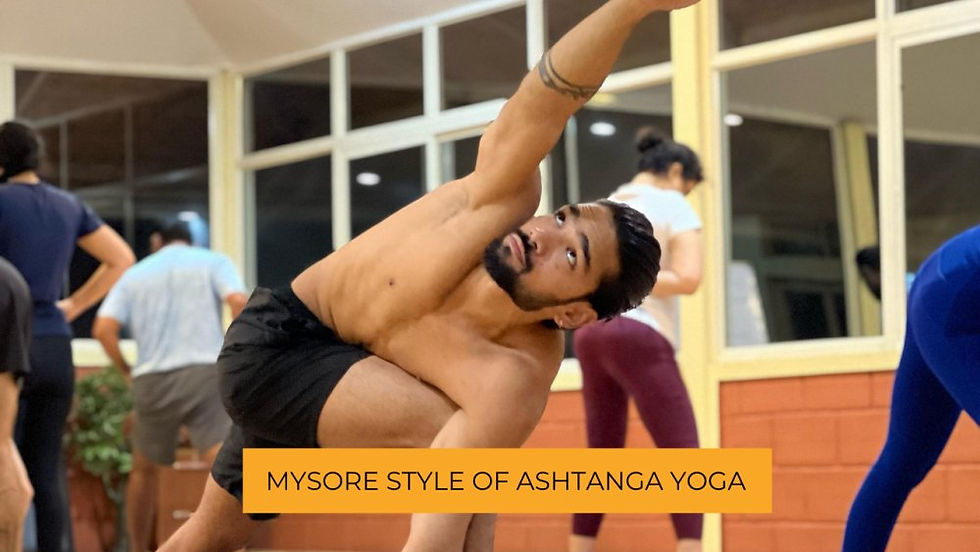A Beginner’s Guide to Start Asana practice
- Yogacharya Rakesh

- May 31, 2021
- 3 min read
Updated: Jul 18, 2022
Though Yoga is for everyone, how to start my Yoga practise if I never did Yoga before? Here is a beginner’s guide to starting asana practice. The below are the 10 most simple, yet highly beneficial yoga asanas that anyone can start with.
This can be your first step into Yoga asana practice. Practice one asana at a time giving a few breaths of relaxation between two asanas and try to keep yourself for longer breaths in these asanas.
1. Balasana (Child’s Pose)
Meaning: Balasana as the name suggests, is a pose that children love to do. It is your default asana to rest, relax and refocus on your practice.

Benefits: It helps to gently stretch the lower back, hips, thighs, knees and ankles while relaxing the spine, shoulders and neck.
Modifications: Keep a block on the floor to keep the forehead on the block or a cushion. It makes the practice of Balasana easier.
2. Adhomukha Shvanasana (Downward-Facing Dog)
Meaning: Inspired by the downward-facing stretch of a dog, this asana is a great foundation for a ton of asanas.

Benefits: One of the significant hurdles in asana practice is the stiffness in your hamstrings. This asana stretches your hamstrings, assists in lengthening the spine and builds your arm strength too. Adhomukha Shvanasana, that’s why it is the go-to-asana in every yoga class.
Modification: If you are finding difficulties, bend your knees in the asana keeping your spine elongated all the while.
3. Dandasana (Plank Pose)
Meaning: As the name suggests, the body looks like a stick with the palms and toes support.

Benefits: It helps in building the core, arm strength and increases stamina.
Modification: Keep your knees down on the floor, if you find it difficult to practice.
4. Chaturanga Dandasana (Plank Pose)
Meaning: The same plank pose with elbows bent. The asana is practised with four ‘chatur’ limbs ‘anga’ and with four limbs you are creating the body like a stick.

Benefits: It helps in building the core, arm strength and increases stamina.
Modification: Keep your knees down on the floor, if you find it difficult to practice.
5. Vriskhasana
Meaning: Inspired by the balance of a tree, it is practised with one foot on the thigh of the other foot.
Benefits: It is a balancing asana. It helps in increasing your mental stability and concentration. Beyond helping improve your balance, it can also strengthen your core, ankles, calves, thighs and spine.
Modification: You can stand against the wall if you find the practice difficult.

6. Trikonasana
Meaning: You are creating a triangle, with your legs and hands and thus named Trikona asana.
Benefits: It helps in strengthening the legs, stretches the groins, spine while increasing the mobility in the hips and neck.

Modification: If you have high blood pressure/Neck pain, look down instead of looking at the upper palm. You can also place the palm in front of the shin bone if you can’t reach all the way down to the big toe.
7. Vakrasana (Twisted Pose)
Meaning: Vakra literally means twist in Sanskrit. This is the simple twist for beginner’s yoga practices.

Benefits: This twisting pose can increase the flexibility in your back while stretching the shoulders, hips and chest. It can also help relieve tension in the middle of your back.
Modification: Instead of placing the armpit to twist, use the tip of the elbow. This reduces the twist and makes it easy.
8. Bhujangasana (Cobra Pose)
Meaning: The body is made like a cobra with the upper body like the hood of a cobra. Bhujanga literally means the one that moves with the support of the torso.

Benefits: The Bhujangasana can help strengthen the back muscles, increase spinal flexibility and stretches the chest, shoulders and abdomen.
Modifications: Keep the forearms down to practice ‘Baby Cobra’.
9. Setubandhasana (Bridge Pose)
Meaning: By lifting the torso while keeping the feet down, the body position looks like a bridge created.

Benefits: This is a back-bending pose that stretches the muscles of the chest, back and neck. It also builds strength in the back and hamstring muscles.
Modification: You can place a block under your pelvis if your lower back is bothering you.
10. Shavasana (Corpse Pose)
Meaning: Like life, yoga classes typically end with this pose. As the name suggests, the body is relaxed on the floor like a corpse.

Benefits: This is a relaxation asana. It brings complete relaxation to the body and mind. Often people find it difficult to relax in Shavasana in the beginning. With regular practice, you will see the impact of relaxation.
Modification: Use a pillow underneath the head to make the practice easier.
If you are new to asana practice, the abovementioned set of asanas are good to start your practice. Regular practise of these asanas can help you in building stamina, strength and flexibility.
Thereafter, you can start practising other asanas and build a practice for an hour or 90 mins. You can check this YouTube Video for a 90 min asana practice.




Comments